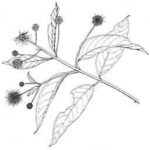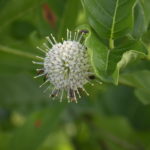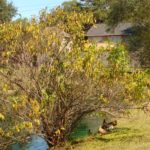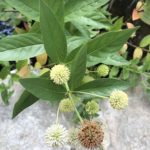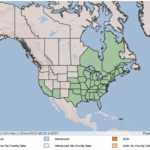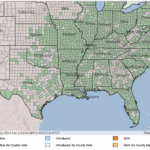Cephalanthus occidentalis
USDA, NRCS. 2018. The PLANTS Database (http://plants.usda.gov, 28 March 2018). National Plant Data Team, Greensboro, NC 27401-4901 USA.
Illustration courtesy of University of Florida/IFAS Center for Aquatic and Invasive Plants. Used with permission.
What is Buttonbush?
Physical Characteristics
- Shrub or small tree
Leaves:
- Opposite
- Stout or slender leaf stalk
- Leaf stalks up to 1.19 inches long
- Sword-shaped
- Up to 7.5 inches long & 3.25 inches wide
- Bright green on top
- Fleshy or covered in soft hairs on bottom
- Small leaves 0.78-0.16 inches long
- Distinct, long veins
Flowers:
- Peduncle simple or branching
- Peduncles up to 3 inches long
- Flower head about 0.59 inches in diameter
- Sepals about 0.05 inches long
- Sepal lobes rounded
- Petals 0.2-0.36 inches long
- 4-5 petals per flower
- Flowers globe shaped
Fruit:
- Dry
- 0.16-0.31 inches long
Seed:
- Single seed
- Brown in color
- Large extra seed coat, white in color
Stem/Trunk:
- Up to 45 feet high
- Rarely 1 foot in diameter
- Slender
- Brown or grayish in color
- Fleshy
- Short & covered in soft, short hairs
Where Does it Grow?
Buttonbush can be found in swamps, marshes, around ponds, and edges of streams.
Pros and Cons of Buttonbush
Buttonbush seeds are occasionally eaten by ducks, but the bush itself is used for nesting by many bird species. Submerged portions of all aquatic plants provide habitats for many micro and macro invertebrates. These invertebrates in turn are used as food by fish and other wildlife species (e.g. amphibians, reptiles, ducks, etc.). After aquatic plants die, their decomposition by bacteria and fungi provides food (called “detritus”) for many aquatic invertebrates.
